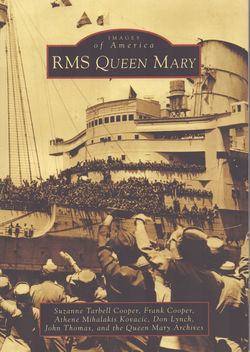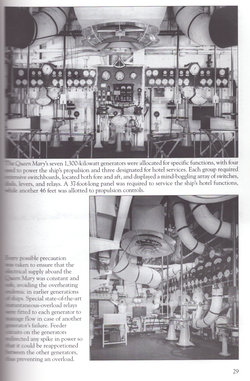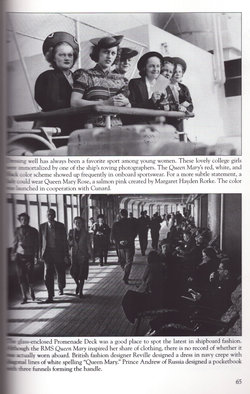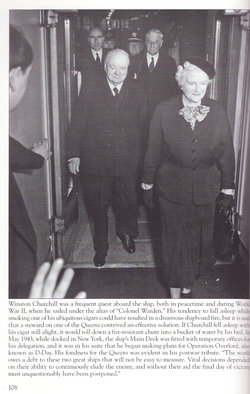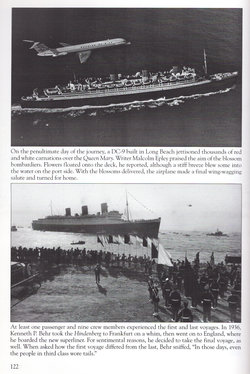RMS
QUEEN MARY BLUE RIBAND TRANS ATLANTIC BRITISH OCEAN LINER WW2 TROOPSHIP
IMAGES OF AMERICA SOFTBOUND BOOK
in ENGLISH by SUZANNE TARBELL COOPER, FRANK COOPER, ATHENE MIHALAKIS KOVACIC,
DON LYNCH, JOHN THOMAS and THE QUEEN MARY ARCHIVES
---------------------------
Additional Information from Internet
Encyclopedia
RMS Queen Mary is a retired
British ocean liner that sailed primarily on the North Atlantic Ocean from 1936
to 1967 for the Cunard Line and was built by John Brown & Company in
Clydebank, Scotland. Queen Mary, along with RMS Queen Elizabeth,[4] was built
as part of Cunard's planned two-ship weekly express service between
Southampton, Cherbourg and New York. The two ships were a British response to
the express superliners built by German, Italian and French companies in the
late 1920s and early 1930s.
Queen Mary sailed on her maiden
voyage on 27 May 1936 and won the Blue Riband that August; she lost the title
to SS Normandie in 1937 and recaptured it in 1938, holding it until 1952, when
it was taken by the new SS United States. With the outbreak of World War II,
she was converted into a troopship and ferried Allied soldiers during the conflict.
On one voyage in 1943, she carried over 16,600 people, the still-standing
record for the most people on a vessel.
Following the war, Queen Mary
was refitted for passenger service and along with Queen Elizabeth commenced the
two-ship transatlantic passenger service for which the two ships were initially
built. The two ships dominated the transatlantic passenger transportation
market until the dawn of the jet age in the late 1950s. By the mid-1960s, Queen
Mary was ageing and was operating at a loss.
After several years of decreased
profits for Cunard Line, Queen Mary was officially retired from service in
1967. She left Southampton for the last time on 31 October 1967 and sailed to
the port of Long Beach, California, United States, where she was permanently
moored. The City of Long Beach bought the ship to serve as a tourist attraction
featuring restaurants, a museum and a hotel. The city contracted out management
of the ship to various third-party firms over the years. It took back
operational control in 2021.
With Weimar Germany launching
Bremen and Europa into service, Britain did not want to be left behind in the
shipbuilding race. White Star Line began construction on their 80,000-ton
Oceanic in 1928, while Cunard planned a 75,000-ton unnamed ship of their own.
Construction on the ship, then
known only as "Hull Number 534", began in December 1930 on the River
Clyde by the John Brown & Company shipyard at Clydebank in Scotland. Work
was halted in December 1931 due to the Great Depression and Cunard applied to
the British Government for a loan to complete 534. The loan was granted, with
enough money to complete the unfinished ship, and also to build a running mate,
with the intention to provide a two ship weekly service to New York.
One condition of the loan was
that Cunard merge with the White Star Line,[8] another struggling British
shipping company, which was Cunard's chief British rival at the time and which
had already been forced by the depression to cancel construction of its
Oceanic. Both lines agreed and the merger was completed on 10 May 1934. Work on
Queen Mary resumed immediately and she was launched on 26 September 1934.
Completion ultimately took 3+1⁄2 years and cost 3.5 million pounds sterling,[7]
then equal to $17.5 million (equivalent to $310 million in 2023). Much of the
ship's interior was designed and constructed by the Bromsgrove Guild.[9] Prior
to the ship's launch, the River Clyde had to be specifically deepened to cope
with her size, this being undertaken by the engineer D. Alan Stevenson.
The ship was named after Mary of
Teck, consort of King George V. Until her launch, the name was kept a closely
guarded secret. Legend has it that Cunard intended to name the ship Victoria,
in keeping with company tradition of giving its ships names ending in
"ia", but when company representatives asked the King's permission to
name the ocean liner after Britain's "greatest Queen", he said his
wife, Mary of Teck, would be delighted.[11] And so, the legend goes, the
delegation had, of course, no other choice but to report that No. 534 would be
called Queen Mary.
This story has always been
denied by company officials, and traditionally the names of royal family
members have only been used for capital ships of the Royal Navy. This anecdote
has been widely contested ever since Frank Braynard published it in his 1947
book, Lives of the Liners. Some support for the story was provided by
Washington Post editor Felix Morley, who sailed as a guest of the Cunard Line
on Queen Mary's 1936 maiden voyage. In his 1979 autobiography, For the Record,
Morley wrote that he was placed at a table with Sir Percy Bates, chairman of
the Cunard Line. Bates told him the story of the naming of the ship "on
condition you won't print it during my lifetime." The story was finally
proven in 1988 when Braynard attended the same dinner party as Eleanor Sparkes,
daughter of Sir Ashley Sparkes, who'd been with Bates during the conversation
with George V. She confirmed the "favourite ship story" to him,
telling the exact anecdote that Braynard had published in his book.
Despite this, Cunard still
denies the name change. It is also possible the name Queen Mary was decided
upon as a compromise between Cunard and the White Star Line, as both lines had
naming traditions. White Star used names ending in "ic", while Cunard
used names ending in "ia".
The name had already been given
to the Clyde turbine steamer TS Queen Mary, so Cunard made an arrangement with
its owners and this older ship was renamed Queen Mary II.
Queen Mary was fitted with 24
Yarrow boilers in four boiler rooms and four Parsons turbines in two engine
rooms. The boilers delivered 400 pounds per square inch (28 bar) steam at 700
°F (371 °C) which provided a maximum of 212,000 shp (158,000 kW) to four
propellers, each turning at 200 RPM.
Pre-Second World War
In 1934 the new liner was
launched by Her Majesty Queen Mary as RMS Queen Mary. On her way down the
slipway, Queen Mary was slowed by eighteen drag chains, which checked the
liner's progress into the River Clyde, a portion of which had been widened to
accommodate the launch.
When she sailed on her maiden
voyage from Southampton on 27 May 1936, she was commanded by Sir Edgar Britten,
who had been the master designate for Cunard White Star whilst the ship was
under construction at the John Brown shipyard. Queen Mary measured 80,774 gross
register tons (GRT), making her the world's largest passenger ship.[18] Her
rival Normandie, only measured 79,280 GRT. Queen Mary sailed at high speed for
most of her maiden voyage to New York, until heavy fog forced a reduction of
speed on the final day of the crossing, arriving in New York Harbor on 1 June
1936.
Queen Mary's design was
criticised for being too traditional, especially when Normandie's hull was
revolutionary with a clipper-shaped, streamlined bow. Except for her cruiser
stern, she seemed to be an enlarged version of her Cunard predecessors from the
pre-First World War era. Her interior design, while mostly Art Deco, seemed
restrained and conservative when compared to the ultramodern French liner.
Nonetheless Queen Mary proved to be the more popular vessel than her rival, in
terms of passengers carried.
In August 1936, Queen Mary
captured the Blue Riband from Normandie, with average speeds of 30.14 knots
(55.82 km/h; 34.68 mph) westbound and 30.63 knots (56.73 km/h; 35.25 mph)
eastbound. That same month, Normandie returned to service after a refit that increased
her size to 83,243 GRT, reclaiming the title of world's largest passenger
ship.[20] In 1937, Normandie received a new set of propellers and reclaimed the
Blue Riband. However, in 1938, under the command of Robert B. Irving, Queen
Mary took back the Blue Riband in both directions,[21] with average speeds of
30.99 knots (57.39 km/h; 35.66 mph) westbound and 31.69 knots (58.69 km/h;
36.47 mph) eastbound, records which stood until lost to United States in 1952.
Interior
Among facilities available on
board Queen Mary, the liner featured two indoor swimming pools, beauty salons,
libraries and children's nurseries for all three classes, a music studio and
lecture hall, telephone connectivity to anywhere in the world, outdoor paddle
tennis courts and dog kennels. The largest room on board was the cabin class
(first class) main dining room (grand salon), spanning three stories in height
and anchored by wide columns. The ship had many air-conditioned public rooms on
board. The cabin-class swimming pool facility spanned over two decks in height.
This was the first ocean liner to be equipped with her own Jewish prayer room –
part of a policy to show that British shipping lines avoided the antisemitism
evident in Nazi Germany.
The cabin-class main dining room
featured a large map of the transatlantic crossing, with twin tracks
symbolising the winter/spring route (further south to avoid icebergs) and the
summer/autumn route. During each crossing, a small motorised model of Queen
Mary would travel along the mural to indicate the vessel's progress en route.
As an alternative to the main
dining room, Queen Mary featured a separate cabin-class Verandah Grill on the
Sun Deck at the upper aft of the ship. The Verandah Grill was an exclusive à la
carte restaurant with a capacity of approximately eighty passengers and was
converted to the Starlight Club at night. Also on board was the Observation
Bar, an Art Deco-styled lounge with wide ocean views. Arthur J. Davis of
Messrs, Mewes and Davis, and Benjamin Wistar Morris designed the Queen Mary's
interior spaces, including the staircases, foyers, and entrances, which were
constructed by H.H. Martyn & Co.
Woods from different regions of
the British Empire were used in her public rooms and staterooms. Accommodation
ranged from fully equipped, luxurious cabin (first) class staterooms to modest
and cramped third-class cabins. Artists commissioned by Cunard in 1933 for
works of art in the interior include Edward Wadsworth and A. Duncan Carse.
In late August 1939, Queen Mary
was on a return run from New York to Southampton. The international situation
led to her being escorted by the battlecruiser HMS Hood. She arrived safely and
set out again for New York on 1 September. By the time she arrived, war had
been declared and she was ordered to remain in port alongside Normandie until
further notice.
In March 1940, Queen Mary and
Normandie were joined in New York by Queen Mary's new running mate Queen
Elizabeth, fresh from her secret voyage from Clydebank. The three largest
liners in the world sat idle for some time until the Allied commanders decided
that all three ships could be used as troopships. Normandie was destroyed by
fire during her troopship conversion. Queen Mary left New York for Sydney,
Australia in March 1940, where she, along with several other liners, was
converted into a troopship to carry Australian and New Zealand soldiers to the
United Kingdom.
In the conversion, the ship's
hull, superstructure, and funnels were painted navy grey. As a result of her
new colour, and in combination with her great speed, she became known as the
"Grey Ghost". To protect against magnetic mines, a degaussing coil
was fitted around the outside of the hull. Inside, stateroom furniture and
decoration were removed and replaced with triple-tiered (fixed) wooden bunks,
which were later replaced by "standee" (fold-up) bunks.
A total of 6 miles (10 km) of
carpet, 220 cases of china, crystal and silver services, tapestries, and
paintings were removed and stored in warehouses for the duration of the war.
The woodwork in the staterooms, the cabin-class dining room, and other public
areas were covered with leather. Queen Mary and Queen Elizabeth were the
largest and fastest troopships involved in the war, often carrying as many as
15,000 men in a single voyage, and often travelling out of convoy and without
escort. Indeed, only a handful of ships, such as the Polish destroyer ORP
Blyskawica, could even provide an escort. The Queens high speed and zigzag
courses made it virtually impossible for U-boats to catch them, although one
attempted to attack the ship. On 25 May 1944, U-853 spotted Queen Mary and
submerged to attack, but the ship outran the U-boat before it could do so.[28]
Because of their importance to the war effort, Adolf Hitler offered a bounty of
1 million Reichsmarks and Oak Leaves to the Knight's Cross, Germany's highest
military honor, to any U-boat captain that sank either ship.
The Queen Mary was not so lucky
throughout the war. On 2 October 1942, she accidentally sank one of her escort
ships, slicing through the light cruiser HMS Curacoa off the Irish coast with a
loss of 338 lives. Queen Mary was carrying thousands of Americans of the 29th
Infantry Division[30] to join the Allied forces in Europe.[31] Due to the risk
of U-boat attacks, Queen Mary was under orders not to stop under any
circumstances and steamed onward with a fractured stem. Some sources claim that
hours later, the convoy's lead escort, consisting of Bramham and one other
ship,[32] returned to rescue 99 survivors of Curacoa's crew of 437, including
her captain John W. Boutwood.[33][34][35] This claim is contradicted by the
liner's then Staff Captain Harry Grattidge, who recorded that Queen Mary's
Captain, Gordon Illingsworth, immediately ordered the accompanying destroyers
to look for survivors within moments of Curacoa's sinking.
Later that year, from 8–14
December 1942, Queen Mary carried 10,389 soldiers and 950 crew (total
11,339).[38] During this trip, on 11 December, while 700 miles (1,100 km) from
Scotland during a gale, she was suddenly broadsided on her starboard side by a
rogue wave that might have reached a height of 28 metres (92 ft).[39] An
account of this crossing can be found in Carter's book. As quoted in the book,
Carter's father, Dr. Norval Carter, part of the 110th Station Hospital on board
at the time, wrote in a letter that at one point Queen Mary "damned near
capsized... One moment the top deck was at its usual height and then, swoom!
Down, over, and forward she would pitch." It was calculated later that the
ship rolled 52 degrees, and would have capsized had she rolled another three
degrees.
From 25 to 30 July 1943, Queen
Mary carried 15,740 soldiers and 943 crew (total 16,683),[42] a standing record
for the most passengers ever transported on one vessel. This was only possible
in summer as passengers had to sleep on deck.
During the war, Queen Mary
carried British Prime Minister Winston Churchill across the Atlantic three
times for meetings with fellow Allied forces officials. He was listed on the
passenger manifests as "Colonel Warden".[45] On one crossing in 1943,
Churchill and his staff planned the Normandy Invasion and he signed the D-Day
Declaration aboard.[46] Churchill later stated that the Queens,
"challenged the fury of Hitlerism in the battle of the Atlantic. Without
their aid, the day of final victory must unquestionably have been postponed.”
By the war's end, Queen Mary had carried over 800,000 troops and traveled over
600,000 miles across the world's oceans.



